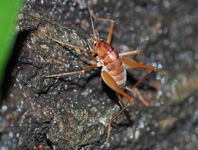Abstract
Dasypoda bees are host-specialized solitary species distributed in the Palaearctic Region. In the framework of a global revision of this genus, comprehensive descriptions of three rare species (D. tibialis Morawitz, D. vulpecula Lebedev and D. iberica Warncke) are presented. The detailed morphology of the D. tibialis male and both sexes of D. vulpecula are given for the first time after a very partial original description. The females of D. tibialis and D. iberica are described for the first time and additional morphological characters of the male of D. iberica are provided. The lectotype of Dasypoda tibialis is designated. Host-plants and new localities are also presented.
References
Ascher, J.S. & Pickering, J. (2018) Discover Life bee species guide and world checklist (Hymenoptera: Apoidea: Anthophila). Available from: http://www.discoverlife.org/mp/20q?guide=Apoidea_species (accessed 1 June 2019)
Baker, D.B. (2002) A provisional annotated list of the nominal taxa assigned to the genus Dasypoda Latreille, 1802, with the description of an additional species (Hymenoptera, Apoidea, Melittidae). Deutsche entomologische Zeitschrift, 49, 89–103.
https://doi.org/10.1002/mmnd.20020490107
Blank, S.M. & Kraus, M. (1994) The nominal taxa described by K. Warncke and their types (Insecta, Hymenoptera, Apoidea). Linzer biologische Beitrage, 26 (2), 665–761.
Davletkeldiev, A.A. (ed.) (2006) Red Data Book of Kyrgyz Republic. 2 Edition. State agency on environment protection and forestry under the Government of Kyrgyz Republic, Institute for Biology and Pedology of National Academy of Sciences of Kyrgyz Republic, Ecological Movement “Aleine” of Kyrgyzstan, Bishkek, 544 pp.
Herrera, J. (1988) Pollination relationships in southern Spanish Mediterranean shrublands. Journal of Ecology, 76, 274–287.
https://doi.org/10.2307/2260469
Lara Ruiz, J. (2013) Fuentes alimenticias de los Melittidae ibéricos. Micobotánica-Jaén, 8 (3), 18–22.
Latreille, P.A. (1802) Histoire naturelle des fourmis, et recueil de meìmoires et d’observations sur les abeilles, les araigneìes, les faucheurs, et autres insectes. Théophile Barrois père, Paris, xvi + 445 pp., xii pls.
https://doi.org/10.5962/bhl.title.65810
Lebedev, A.G. (1929) Neue Bienen-Arten aus S.S.S.R. Konowia, 8 (3), 268–272.
Michener, C.D. (2007) The bees of the world, second edition. The Johns Hopkins University Press, Baltimore, xvi + [i] + 953 pp., 20 pls.
Michez, D. (2005) Dasypoda (Megadasypoda) intermedia sp. nov. (Hymenoptera, Apoidea, Melittidae), new species from Iran. Zoologische Mededelingen, 79 (6), 123–127.
Michez, D., Patiny, S., Rasmont, P., Timmermann, K. & Vereecken, N. (2008) Phylogeny and host-plant evolution in Melittidae s.l. (Hymenoptera: Apoidea). Apidologie, 39 (1), 146–162.
https://doi.org/10.1051/apido:2007048
Michez, D. & Pauly, A. (2012) A new species of the palaearctic genus Dasypoda Latreille 1802 (Hymenoptera: Dasypodaidae) from the Great Rift Valley in Ethiopia. Zootaxa, 3181 (1), 63–68.
https://doi.org/10.11646/zootaxa.3181.1.5
Michez, D., Terzo, M. & Rasmont, P. (2004a) Révision des espèces ouest-paléarctiques du genre Dasypoda Latreille 1802 (Hymenoptera, Apoidea, Melittidae). Linzer biologische Beiträge, 36 (2), 847–900.
Michez, D., Terzo, M. & Rasmont, P. (2004b) Phylogénie, biogéographie et choix floraux des abeilles oligolectiques du genre Dasypoda Latreille 1802 (Hymenoptera: Apoidea: Melittidae). Annales de la Société Entomologique de France, New Series, 40 (3–4), 421–435.
https://doi.org/10.1080/00379271.2004.10697431
Morawitz, F.F. (1880) Ein Beitrag zur Bienen-Fauna Mittel-Asiens. Bulletin de l‘Académie Impériale des Sciences de St.-Pétersbourg, 26 (22/36), 337–389.
Ornosa, C. & Ortiz-Sánchez, F.J. (l998) Contibución al conocimiento de los melitidos ibéricos (Hymenoptera, Apoidea, Melittidae). Boletín de la asociación española de Entomología, 22 (3–4), 181–202.
Ornosa, C. & Ortiz-Sánchez, F.J. (2004) Hymenoptera, Apoidea I. In: Ramos, M.A., Alba, J., Bellés, X., Gonsálbes, J., Guerra, A., Macpherson, E., Martin, F., Serrano, J. & Templado, J. (Eds.), Fauna Ibérica. Vol. 23. Museo Nacional de Ciencias Naturales, CSIC, Madrid, 556 pp.
Popov, V.B. (1957) New species and the geographical distribution of the bee genus Eremaphanta Popov (Hymenoptera, Melittidae). Zoologichesky Zhurnal, 36 (11), 1706–1716. [in Russian]
Radchenko, V.G. (1996) Evolution of nest building in bees (Hymenoptera, Apoidea). Entomological Review, 75 (6), 20–32.
Radchenko, V.G. (2016) A new widespread European bee species of the genus Dasypoda Latreille (Hymenoptera, Apoidea). Zootaxa, 4184 (3), 491–504.
https://doi.org/10.11646/zootaxa.4184.3.4
Radchenko V.G. (2017) A new bee species of the genus Dasypoda Latreille (Hymenoptera, Apoidea) from Portugal with comparative remarks on the subgenus Heterodasypoda Michez. Zootaxa, 4350 (1), 164–176.
https://doi.org/10.11646/zootaxa.4350.1.10
Radchenko, V.G. & Pesenko, Yu.A. (1996) “Protobee” and its nests: a new hypothesis concerning the early evolution of Apoidea (Hymenoptera). Entomological Review, 75 (2), 140–162.
Warncke, K. (1973) Die westpaläarktischen Arten der Bienenfamilie Melittidae (Hymenoptera). Polskie Pismo Entomologiczne, 43 (1), 97–126.

